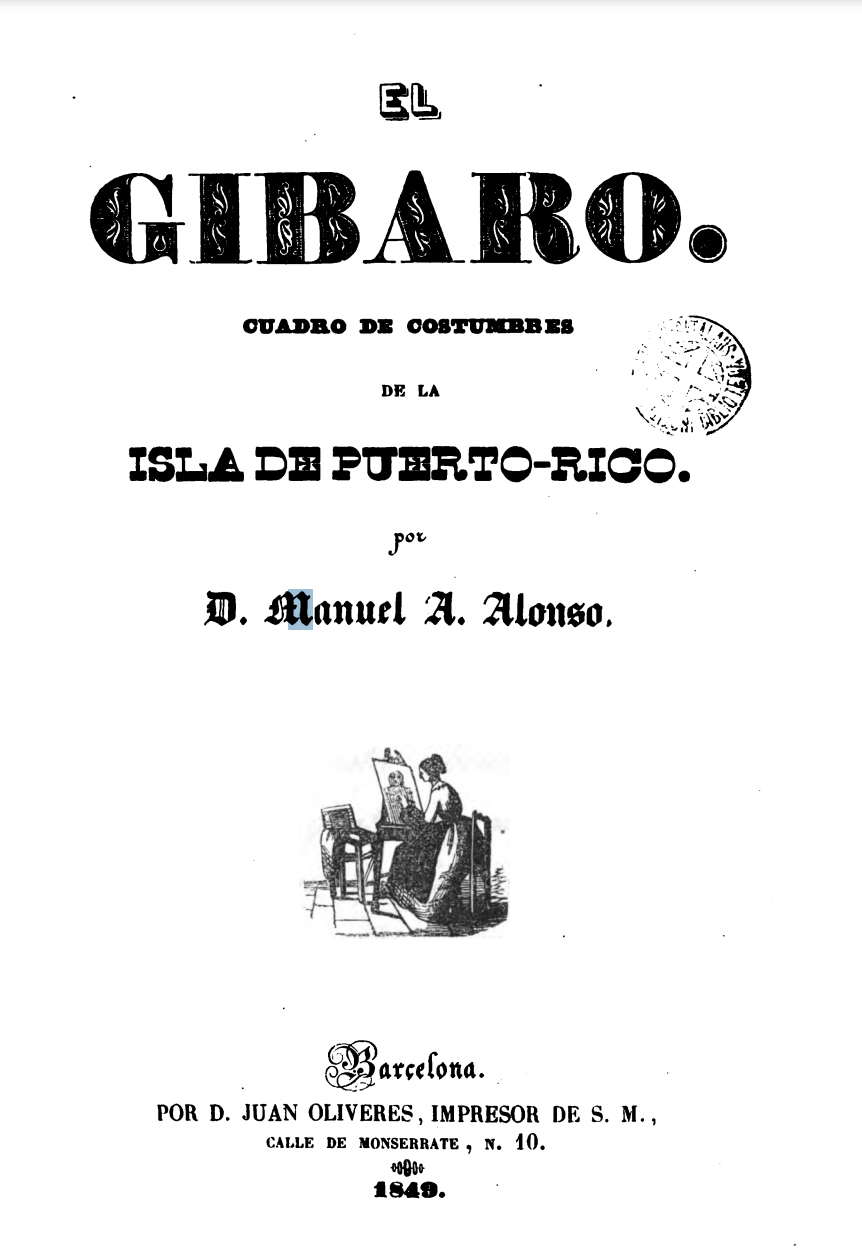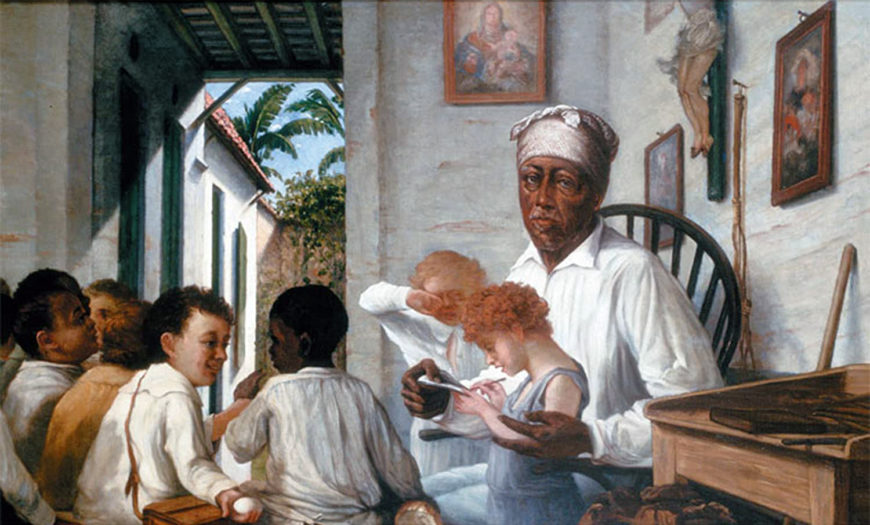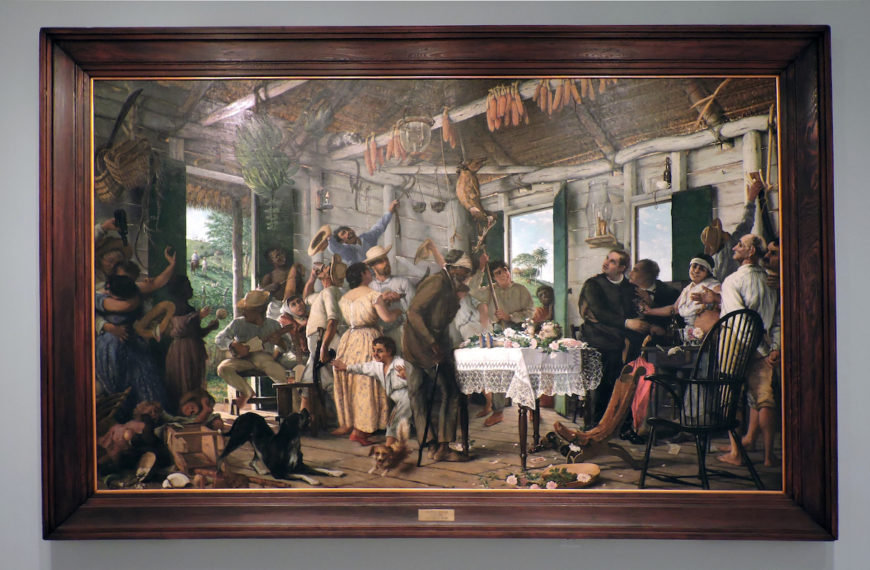
Francisco Oller y Cestero, The Wake, 1893, oil on canvas, 269.24 x 411.47cm (Museum of History, Anthropology, and Art, University of Puerto Rico, Rio Piedras campus; photo: Tamara Díaz Calcaño, CC BY-NC-SA 2.0)
A monumental painting, at 8′10″ tall and 13’6″ wide (269.24 x 411.47cm), showcases a dynamic scene filled with figures in the interior of a humble, domestic structure, called a bohío. Its subject is a Puerto Rican rural tradition, the sad yet celebratory wake for a small child. The artist, Francisco Oller, filled it with details of the everyday life of rural folk, like their farming tools, furniture, and foodstuffs.
Oller’s El velorio (The Wake) was shown to the public for the first time during the 1893 Exposition of Puerto Rico in San Juan, an event marking the fourth centenary of the territory being under Spanish administration, and it included art, technology, and agricultural exhibitions. The educator Alejandro Infiesta wrote at the time that almost everybody who saw the painting exclaimed they knew someone just like one of the many figures in the composition. [1] But this painting is both a celebration and a condemnation of aspects of the lives of the rural population, specially the jíbaros (farmers and other members of the rural population), highlighting the complexities of the developing Puerto Rican identity in the 19th century.

Detail showing the body of the child on the table and a man who has come to pay his respects to the child. Francisco Oller y Cestero, The Wake, 1893, oil on canvas, 269.24 x 411.47cm (Museum of History, Anthropology, and Art, University of Puerto Rico, Rio Piedra campus)
Setting the scene
The main subject of this composition is at the center, the sole moment of quiet in an otherwise hectic scene. The pale body of a small child lies on a lace covered table with his hands arranged as in prayer, with the tabletop and the body adorned with flowers. This is his wake. Before the table stands an older Black man, a formerly enslaved person, in still contemplation. He carries a cane, and his clothes are ragged; he seems to have encountered the wake and stepped inside to pay his respects. [2] He is the only person looking at the deceased child. The rest of the composition is dominated by the family and community taking part in the event.
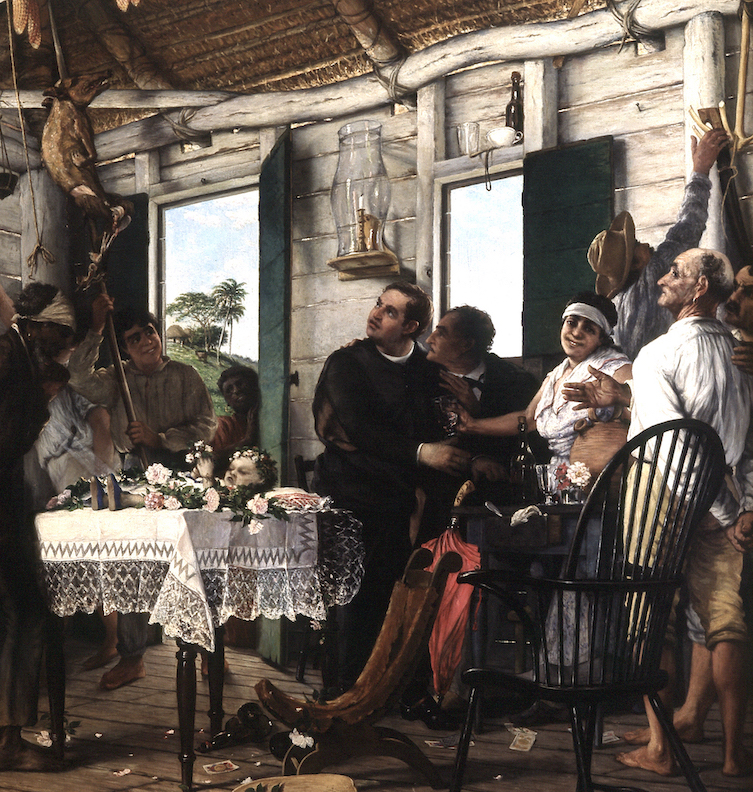
Detail showing the right side of the painting, with a man reaching for a machete hanging from the wall behind the mother of the dead child. Francisco Oller y Cestero, The Wake, 1893, oil on canvas, 269.24 x 411.47cm (Museum of History, Anthropology, and Art, University of Puerto Rico, Rio Piedra campus)
On the right side of the painting, we find the mother of the child, wearing a white headband. She looks out toward the viewer, with a smile that doesn’t quite reach her eyes while handing the priest a drink. The priest, accompanied by the sacristan, turns away to gaze not at the dead child but at the roasted pig that is being brought into the house. The pig is held aloft on a long stick by a young man, who lifts it toward the ceiling beams, almost above the child.
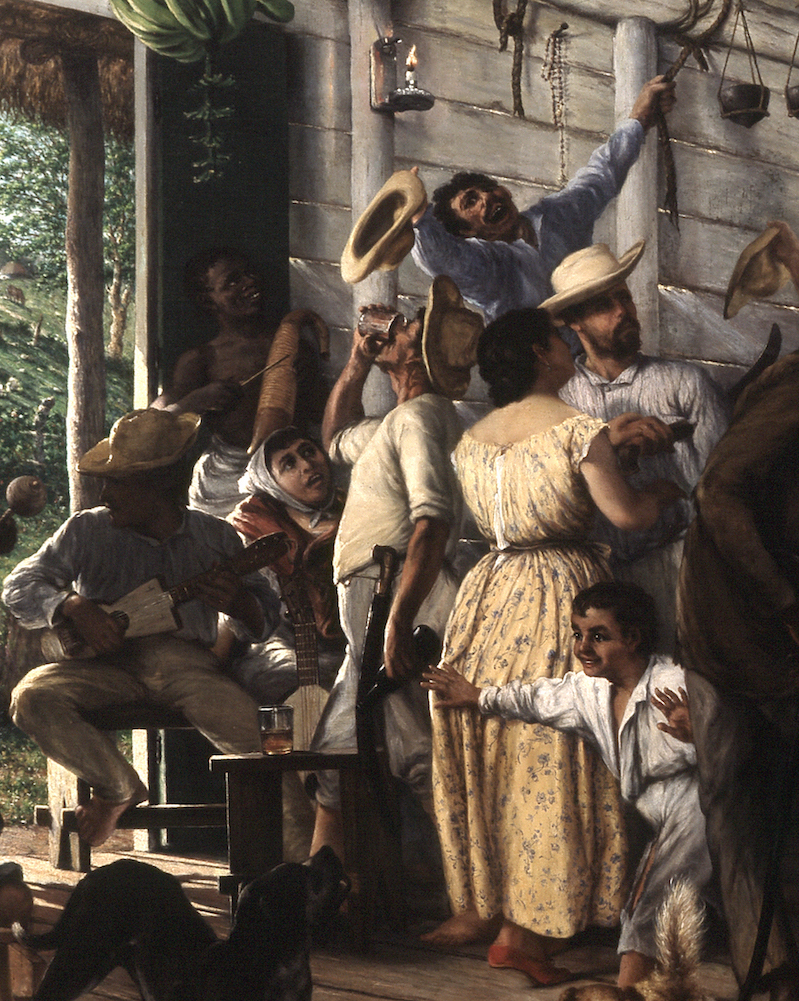
Detail showing the musicians, the woman in the yellow dress, and the man with a machete under his arm. Francisco Oller y Cestero, The Wake, 1893, oil on canvas, 269.24 x 411.47cm (Museum of History, Anthropology, and Art, University of Puerto Rico, Rio Piedra campus)

Francisco Oller y Cestero, The Wake, 1893, oil on canvas, 269.24 x 411.47cm (Museum of History, Anthropology, and Art, University of Puerto Rico, Rio Piedra campus)
From one of the beams hangs a rope from which a man swings himself to sing along with the musicians toward the left side of the composition. His body brings our attention to a man who grips a machete under his arm and a woman in a yellow dress who attempts to calm him. His steely eyes lead us back to the other side of the room, to a man reaching for a machete hanging from the wall (on the right side of the composition). A fight seems imminent. Next to the couple, a group of musicians seem to inhabit their own world, singing and playing along with traditional Puerto Rican instruments.
On the far left of the painting, a couple is interrupted by a drunkard who spills a bottle over their heads. At their feet, three unfortunate children are having their lunch interrupted by a dog that crashed into them as it ran through the house. Their benches, plates, and ditas (bowls) full of rice have fallen to the ground. The offending dog has turned to regard its pursuers, a smaller dog and a young boy in mid stride pushing away the skirts of the woman in yellow.
Oller has painted an almost festive scene, one that may stray away from what many would consider a proper wake—but this one is a baquiné, a funerary tradition once common in rural Puerto Rico. A baquiné, or velorio de angelito (“little angel’s wake”), was the funerary vigil for a child considered too young to have sinned and so their soul was expected to enter heaven. Similar practices also appear in different parts of the Spanish Americas and combined diverse cultural manifestations depending on the region.
The baquiné took from similar traditions in children’s wakes practiced in central and southern Spain, which included dancing and eating and were done for children aged 7 and younger. [3] The African and Afro-descendant population in the Hispanic Caribbean adapted and incorporated their own songs, rhythms, and oral histories from similar West African funerary traditions they could not practice and/or lost through forced Catholic conversion under Spanish colonial rule. [4]
Models for the painting
Oller started work on this painting in 1891 while staying at the Hacienda Santa Bárbara in the northeastern town of Carolina, a property owned by the Elzaburu family. There, he developed oil studies for many of the characters, using the farm workers, and his friends and family as models. The older man at the center of the painting was modeled on a friend of Oller, known as San Pablo; while his granddaughter, Georgina Rossi, modeled for the woman in yellow. The brothers José and Pedro Elzaburu served as models for the priest and the sacristan, while their housekeeper did so for the dead child’s mother. [5]
Interest in the countryside
The painter spent a lot of his time traveling the Puerto Rican countryside after his return from Spain in 1883. He was drawn not only to the landscape but to the people who inhabited it. Puerto Rico’s rural population and customs, especially the jíbaro‘s, were on the minds of many local writers and thinkers of the time. Like in many new countries in the Western sphere, there was interest in the recognition and representation of a national identity. One of the most important examples of this in literature was El gíbaro by Manuel Alonso, published in 1849. The work consists of 21 scenes focused on rural customs, music, and fictionalized interactions between jíbaros that emphasize the way they spoke and behaved.
Alonso highlighted the mixed origins of some of the traditions, how they had sprung from the population’s Spanish, Indigenous, and African ancestry. This miscegenation was an important part in the consideration of the jíbaros by local writers in the 19th century, who saw it as contributing to their physical features and even their moral character. Alonso carefully documented the jíbaro’s manners and customs, identifying in them what is distinct to the territory’s identity and different from Spain. Yet there is also criticism toward many of these rural customs, which the author considered to be products of the population’s ignorance and the allowances of the Catholic Church. Oller’s The Wake, produced 44 years later, sprang from similar concerns and observations.
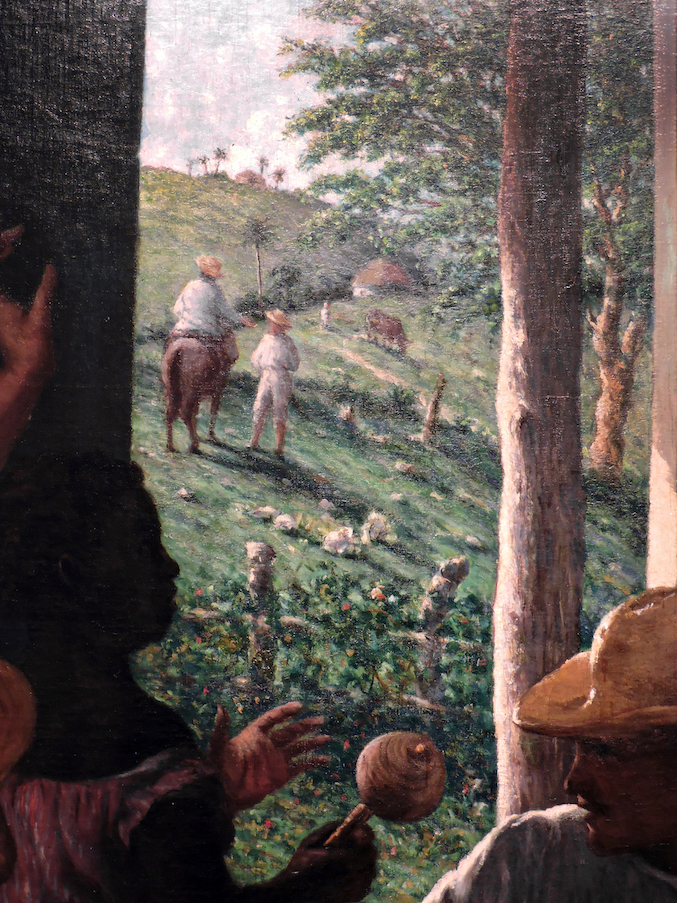
Detail of the landscape, Francisco Oller y Cestero, The Wake, 1893, oil on canvas, 269.24 x 411.47cm (Museum of History, Anthropology, and Art, University of Puerto Rico, Rio Piedras campus; photo: Tamara Díaz Calcaño, CC BY-NC-SA 2.0)
The artist’s influences
We are fortunate to have words from the artist himself about the painting, which he described as “the subject of my loves as an artist.” [6] This statement encourages us to consider Oller’s artistic education in the conception of this work. He was born and raised in Puerto Rico to a prominent San Juan family. As a young boy he studied under Spanish painter Juan Cletos Noa, and later went on to study for a year in the Academy of Fine Arts of San Fernando in Madrid in 1851. This was only the start of his travels between Puerto Rico and Europe.
The most formative period in Oller’s education was his time in Paris from 1858 to 1865, when he frequented the Petite École and studied under Thomas Couture. The young artist became familiar with the works of Realist painter Gustave Courbet, likely when he opened his studio to students from 1861 to 1862. Oller would later identify himself as a student of Courbet and his influence is palpable in The Wake. He also befriended the Caribbean-born Camille Pissarro during the early days of Impressionism. He would return to France for a couple of years in 1873, rekindling friendships and engaging once again with this style, which is present in the large composition. The neighboring hills framed by the windows and doors of the bohío are bathed in light and captured in the swift, short brushstrokes that often characterizes the technique.
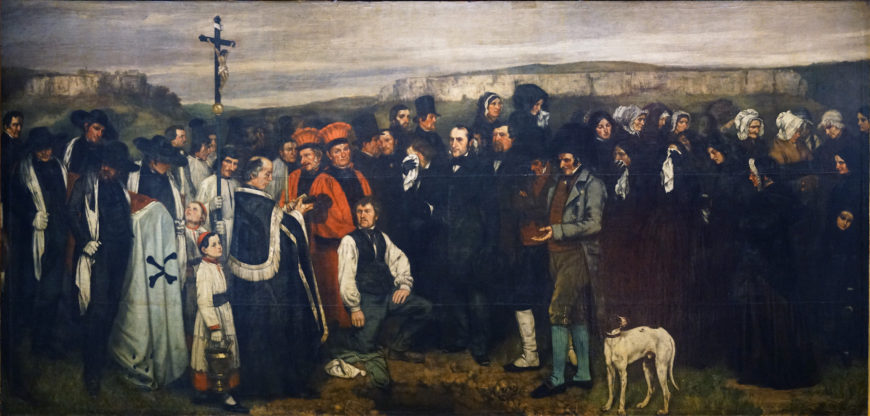
Gustave Courbet, A Burial at Ornans, begun late summer 1849, completed 1850, 124 x 260 inches, oil on canvas (Musée d’Orsay, Paris)
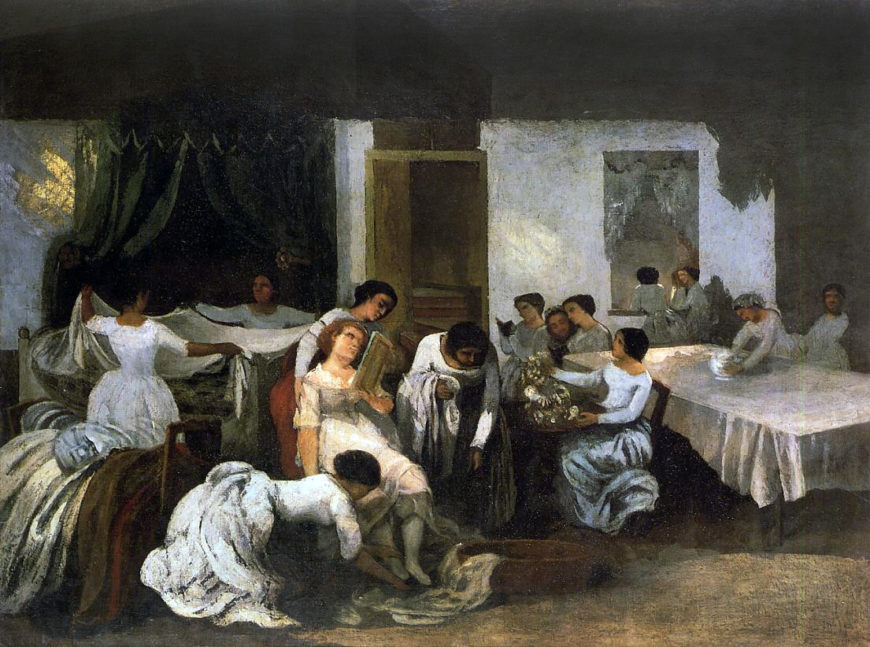
Gustave Courbet, Dressing the Dead Girl, c. 1855, oil on canvas (Smith College Museum of Art (SCMA), Northampton, MA, US)
Many art historians have noted the similarities between The Wake and Courbet’s A Burial at Ornans and the lesser-known work The Preparation of the Dead Girl—paintings that a young Oller could have seen during his first Parisian stay. We can quickly identify parallels between The Wake and A Burial at Ornans, such as the large dimensions, the funerary subject, and the realism in the representation of the figures. They both capture the lives of everyday people, and this includes setting the scenes in their native landscape, and so their respective cultural and geographical context. Oller extends his attention further to the careful representation of the diverse Puerto Rican population, intermingling in a syncretic funeral tradition, as well as to their dress, food, and material culture inside the bohío.
Oller’s last period in Spain should also be considered regarding The Wake, for it has been proposed he had plans for an ambitious composition such as this as early as the 1880s. [7] He lived in Madrid from 1877 to 1883, when costumbrismo was of great interest among painters who wanted to represent regional and rural traditions. Many Spanish painters turned their brushes toward their history and cultural expressions in the mid-to-late 19th century, moved by national and political interest and often through a romantic lens (such as in the work of Rafael Benjumea and Valeriano Domínguez Bécquer). Oller’s encounter with Spanish costumbrismo could have furthered his interest in representing the rural images and sounds of his own native land.
The artist’s intentions

Francisco Oller y Cestero, The Wake, 1893, oil on canvas, 269.24 x 411.47cm (Museum of History, Anthropology, and Art, University of Puerto Rico, Rio Piedra campus)
Oller also described the subject matter of The Wake as “an orgy of brutish appetites under the guise of gross superstition,” effectively signaling his critical approach to the custom. [8] The older Black man at the center is the one figure expressing what was considered an acceptable attitude in the wake of a child. He is the moral example among the rest—and in sharp contrast to the Church, represented by the gluttonous priest. The representation of an older Black man in this role alludes to Oller’s own abolitionist work and paintings like The School of Teacher Rafael Cordero.
Since the 1870s, Oller’s work had occasionally addressed social and political issues like slavery and the colonial relationship of Puerto Rico with Spain, through drawings of the abuse suffered by enslaved people and portraits of local abolitionists, intellectuals, and politicians. The Wake not only brings together Oller’s eclectic art education, but also his continuous interest in the social situation of his homeland. Oller is looking at the jíbaro, aware of the literary and national discourses of the time concerned with what made Puerto Rico different from Spain. It both highlights his belonging to and familiarity with its culturally distinct and racially diverse population, and his position as an educated and socially privileged man in a colonial society. He is taking part in the conversation of what it means to be Puerto Rican and what that looks like without idealizing the figure of the jíbaro nor the influence of colonial institutions.
When shown at the Exposition of Puerto Rico in 1893, some of the negative reactions to The Wake focused primarily on the custom of the baquiné and how the jíbaro was represented. The author, Infiesta, praised Oller for the physical representation of the rural population and for wisely selecting his models and comparing the figures to portraits. [9] He points to Oller’s familiarity with the rural population and time spent in the countryside. Yet Infiesta describes the wake as unnatural and claimed that the smiling woman could not be “the jíbaro’s mother.” [10] His statement speaks to the apprehension toward jíbaros when they were not represented in an idealized manner, which was at odds with accepted expressions of Puerto Rican identity.”
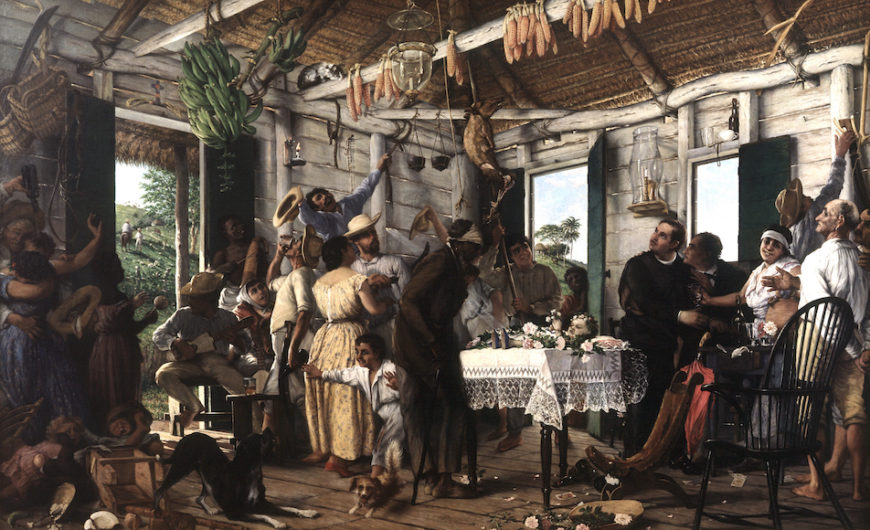
Francisco Oller y Cestero, The Wake, 1893, oil on canvas, 269.24 x 411.47cm (Museum of History, Anthropology, and Art, University of Puerto Rico, Rio Piedra campus)
Notes:
[1] Infiesta, Alejandro. La Exposición de Puerto Rico (San Juan: Imp. del Boletín Mercantil, 1895), p. 102.
[2] Delgado Mercado, Osiris, Francisco Oller y Cestero: Pintor de Puerto Rico (San Juan: Centro de Estudios Superiores de Puerto Rico y el Caribe, 1983), p. 92.
[3] Bantulà Janot, Jaume, and Andrés Payà Rico. “La cultura lúdica en los rituales funerarios de Iberoamérica: los juegos de velorio,” Stvdivm. Revista de Humanidades (Zaragoza: Prensas de la Universidad de Zaragoza, 2014): p. 170
[4] Bantulà Janot, Jaume, and Andrés Payà Rico. “La cultura lúdica en los rituales funerarios de Iberoamérica: los juegos de velorio,” Stvdivm. Revista de Humanidades (Zaragoza: Prensas de la Universidad de Zaragoza, 2014): p. 183
[5] Vaquero, María (Ed.), Francisco Oller y Cestero, 1833–1917 (San Juan: Museo de Historia, antropología y arte, Universidad de Puerto Rico, 1999), pp. 18–19
[6] Cited in Venegas, Haydee E. “Francisco Oller: perfil de un pintor puertorriqueño”, Francisco Oller: Realista del impresionismo (Ed. Marimar Benítez) (Ponce: Museo de Arte de Ponce, 1983), p. 142. Original: “el objeto de mis amores de artista”, translated by Tamara Díaz Calcaño.
[7] Delgado Mercado, Osiris, Francisco Oller y Cestero: Pintor de Puerto Rico (San Juan: Centro de Estudios Superiores de Puerto Rico y el Caribe, 1983), p. 89–90
[8] Cited in Delgado Mercado, Osiris, Francisco Oller y Cestero: Pintor de Puerto Rico (San Juan: Centro de Estudios Superiores de Puerto Rico y el Caribe, 1983), p. 90. Original: “una orgía de apetitos brutales bajo el velo de una superstición grosera”, translated by Tamara Díaz Calcaño.
[9] Infiesta, Alejandro. La Exposición de Puerto Rico (San Juan: Imp. del Boletín Mercantil, 1895), p. 98
[10] Infiesta, Alejandro. La Exposición de Puerto Rico (San Juan: Imp. del Boletín Mercantil, 1895), p. 98
[11] Alonso, Manuel. El gíbaro: cuadro de costumbres de la isla de Puerto Rico (Barcelona: Juan Olivares, Impresor de S.M., 1849), 8. Original: “…he reunido aquellas escenas que juzgo más a propósito para dar una idea de las costumbres de nuestra Antilla, procurando ser exacto como narrador, indulgente o severo según las circunstancias, y teniendo siempre la mira de corregir las costumbres deleitando.” Translated by Tamara Díaz Calcaño
Additional resources
Read about Oller and landscape painting in 19th-century Latin America
Alonso, Manuel. El gíbaro: cuadro de costumbres de la isla de Puerto Rico (Barcelona: Juan Olivares, Impresor de S.M., 1849).
Bantulà Janot, Jaume, and Andrés Payà Rico. “La cultura lúdica en los rituales funerarios de Iberoamérica: los juegos de velorio,” Stvdivm. Revista de Humanidades (Zaragoza: Prensas de la Universidad de Zaragoza, 2014): 167–188. ISSN: 1137-8417
Boime, Albert. The Art of Exclusion (Washington: Smithsonian Institution Press,1990).
Delgado Mercado, Osiris, Francisco Oller y Cestero: Pintor de Puerto Rico (San Juan: Centro de Estudios Superiores de Puerto Rico y el Caribe, 1983).
Díaz Calcaño, Tamara, “Michel-Jean Cazabon y Francisco Oller: pintura y sociedad en el Caribe decimonónico,” PhD. diss., (Complutense University of Madrid, 2019).
González, José E. “La cultura nacional puertorriqueña del siglo diecinueve y Francisco Oller”, Francisco Oller: Realista del impresionismo (Ed. Marimar Benítez) (Ponce: Museo de Arte de Ponce, 1983).
Infiesta, Alejandro. La Exposición de Puerto Rico (San Juan: Imp. del Boletín Mercantil, 1895).
Nochlin, Linda. The Politics of Vision (New York: Harper & Row Publishers, 1989).
Sullivan, Edward J. From San Juan to Paris and Back (New Haven: Yale University Press, 2014).
Vaquero, María (Ed.), Francisco Oller y Cestero, 1833–1917 (San Juan: Museo de Historia, antropología y arte, Universidad de Puerto Rico, 1999).
Venegas, Haydee E. “Francisco Oller: perfil de un pintor puertorriqueño”, Francisco Oller: Realista del impresionismo (Ed. Marimar Benítez) (Ponce: Museo de Arte de Ponce, 1983).

